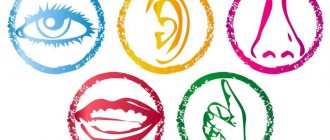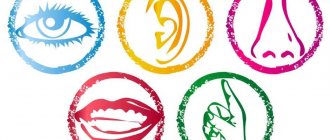Today I continue the topic started in previous materials. In the last article, I talked about a very effective meditation for managing emotions, and today you will learn about another wonderful tool that helps you make friends with your emotions.
Outwardly, today's exercise looks very simple, and therefore it is difficult to believe that with its help you can get at least some significant result. But in fact, its effectiveness can be simply amazing.
The only catch that may arise is the need to perform the exercise regularly, every day. You don’t need much time – maximum 10-15 minutes a day. But even this time, many are too lazy to set aside for themselves. But in vain! The time spent will pay off in spades.
List of moral, intellectual, aesthetic feelings
To the question: “what are the feelings,” each person can give his own answer. Some people often experience strong and deep experiences, while others experience them mildly and short-lived. The ability to feel depends on the temperament, character, principles, priorities and life experience of the individual.
Most often, feelings are classified depending on the sphere in which the object of experience is located:
Moral
These are sympathy and antipathy, respect and contempt, affection and alienation, love and hatred, as well as feelings of gratitude, collectivism, friendship and conscience. They arise in relation to the actions of other people or their own.
They are determined by the moral norms accepted in society and acquired by the individual in the process of socialization, as well as his views, beliefs, and worldview. If other people's or one's own actions correspond to moral standards, satisfaction arises; if not, indignation arises.
Intelligent
A person also has experiences that arise in the process of mental activity or in connection with its result: joy, satisfaction from the process and result of work, discovery, invention. It is also inspiration and bitterness from failure.
Aesthetic
Emotional excitement arises when perceiving or creating something beautiful. A person experiences incredible sensations when he sees the beauty of the Earth or the power of natural phenomena.
A person feels a sense of beauty when looking at a small child or an adult, harmoniously built person. Beautiful works of art and other human creations can evoke delight and elation.
Since this classification does not reveal the entire palette of feelings, they are usually classified on several other grounds.
What are feelings for?
The functions of feelings in psychology are determined by their ability to leave information about significant events and objects.
- reflective - an assessment of what is happening in order to determine the degree of danger in order to find ways to prevent it;
- stimulating - feelings encourage you to look for ways to solve certain problems and determine goals for the future;
- reinforcing - thanks to feelings, a person remembers significant events, giving his own subjective assessment;
- switching - help set priorities, determine more important objects, actions, decisions. In other words, it is willpower;
- adaptive - based on previously experienced feelings, a person can more easily adapt to a new reality;
- communicative - the language of feelings is one of the effective ways to interact with others.
Table of human feelings and emotions
And I also want to show you a collection of feelings, emotions, states that a person experiences during his life - a generalized table that does not pretend to be scientific, but will help you better understand yourself. The table was taken from the website “Communities of Addicted and Codependent”, author - Mikhail.
All human feelings and emotions can be divided into four types. These are fear, anger, sadness and joy. You can find out what type a particular feeling belongs to from the table.
|
|
|
And for those who read the article to the end. The purpose of this article is to help you understand your feelings and what they are. Our feelings largely depend on our thoughts. Irrational thinking is often at the root of negative emotions. By correcting these mistakes (working on our thinking), we can be happier and achieve more in life. There is interesting, but persistent and painstaking work to be done on oneself. You are ready?
This might interest you:
PS And remember, just by changing your consumption, we are changing the world together! econet
All types of feelings
and emotions
can be divided into negative (sadness, fear, hostility, disappointment, anger, despair, guilt, jealousy), positive (happiness, mood, joy, love, gratitude, hope) and neutral (compassion, surprise).
Human feelings in psychology consider subjective experiences of emotions. Experiences and mental states of the body that arise when the brain perceives emotions that appear in external stimuli are considered.
Example: You see a tiger in the distance, you feel a sense of fear and you feel terrified.
Feelings and reactions to emotions occur in an area of the brain. In addition, they are subjective in nature, being influenced by personal experience, memories and beliefs.
The fundamental difference between emotions and feelings, according to neuroscientist Antonio Damasio, is that emotions are involuntary responses, a more complex version of a reflex. For example, when you are in danger and your momentum accelerates. Feeling is awareness of that emotion.
Feelings are part of the human being from birth. We are sensory beings, and we can perceive the world through various senses.
Feelings are part of a person from the moment of birth. We are sensory beings and we can perceive the world through various senses.
Many stimuli awaken our senses: we sense what we think, what we observe, what we hear, what we feel, what we touch, or what we eat.
Emotional reactions
- Lability is the variability of the manifestation of experiences. They always fluctuate over a fairly wide range (from light sentimentality to hysteria).
- Monotony is monotony, static or no sensory responses to what is happening.
- Responsiveness and empathy - the ability to quickly and flexibly respond to external influences, the ability to put oneself in the place of another, to empathize.
- Viscosity – focusing on a long-term feeling (for example, instead of reacting to the situation, a person returns to old grievances, failures).
- Coarsening is the inability to realize the appropriateness and admissibility of expressing emotions, loss of restraint and delicacy.
- Alexithymia is difficulty in identifying one’s feelings and their expression, the inability to distinguish experiences from physical sensations.
- Rigidity – immobility and limited range of response.
Sometimes a person’s behavior is demonstrative in nature, which is associated with his social functions. That is, people portray a certain involvement and emotionality in a situation that requires it. In this case, they speak of the existence of an emotional action, and not a reaction.
Fundamental Emotions
All human emotions can be distinguished by the quality of experience. This aspect of human emotional life is most clearly presented in the theory of differential emotions by the American psychologist K. Izard. He identified ten qualitatively different “fundamental” emotions: interest-excitement, joy, surprise, grief-suffering, anger-rage, disgust-disgust, contempt-disdain, fear-horror, shame-shyness, guilt-remorse. K. Izard classifies the first three emotions as positive, the remaining seven as negative. Each of the fundamental emotions underlies a whole spectrum of conditions that vary in degree of expression. For example, within the framework of such a unimodal emotion as joy, one can distinguish joy-satisfaction, joy-delight, joy-jubilation, joy-ecstasy and others. From the combination of fundamental emotions, all other, more complex, complex emotional states arise. For example, anxiety can combine fear, anger, guilt and interest.
1. Interest is a positive emotional state that promotes the development of skills and knowledge. Interest-excitement is a feeling of capture, curiosity.
2. Joy is a positive emotion associated with the opportunity to sufficiently fully satisfy an actual need, the probability of which was previously small or uncertain. Joy is accompanied by self-satisfaction and satisfaction with the world around us. Obstacles to self-realization are also obstacles to the emergence of joy.
3. Surprise - an emotional reaction to sudden circumstances that does not have a clearly defined positive or negative sign.
Surprise inhibits all previous emotions, directing attention to a new object and can turn into interest.
4. Suffering (grief) is the most common negative emotional state associated with receiving reliable (or seeming) information about the impossibility of satisfying the most important needs, the achievement of which previously seemed more or less likely. Suffering has the character of an asthenic emotion and more often occurs in the form of emotional stress. The most severe form of suffering is grief associated with irretrievable loss.
5. Anger is a strong negative emotional state, often occurring in the form of affect; arises in response to an obstacle in achieving passionately desired goals. Anger has the character of a sthenic emotion.
6. Disgust is a negative emotional state caused by objects (objects, people, circumstances), contact with which (physical or communicative) comes into sharp conflict with the aesthetic, moral or ideological principles and attitudes of the subject. Disgust, when combined with anger, can motivate aggressive behavior in interpersonal relationships. Disgust, like anger, can be directed toward oneself, lowering self-esteem and causing self-judgment.
7. Contempt is a negative emotional state that arises in interpersonal relationships and is generated by a mismatch in the life positions, views and behavior of the subject with those of the object of feeling. The latter are presented to the subject as base, not corresponding to accepted moral standards and ethical criteria. A person is hostile to someone he despises.
8. Fear is a negative emotional state that appears when the subject receives information about possible damage to his life well-being, about a real or imaginary danger. In contrast to suffering caused by direct blocking of the most important needs, a person, experiencing the emotion of fear, has only a probabilistic forecast of possible trouble and acts on the basis of this forecast (often insufficiently reliable or exaggerated). The emotion of fear can be both sthenic and asthenic in nature and occur either in the form of stressful conditions, or in the form of a stable mood of depression and anxiety, or in the form of affect (horror).
9. Shame is a negative emotional state, expressed in the awareness of the inconsistency of one’s own thoughts, actions and appearance not only with the expectations of others, but also with one’s own ideas about appropriate behavior and appearance.
10. Guilt is a negative emotional state, expressed in the awareness of the unseemlyness of one’s own actions, thoughts or feelings and expressed in regret and repentance.
Meditation exercise for understanding emotions
When working with clients, I often use a meditation exercise to help them better understand their own emotions. It is so effective that I decided to make an audio recording so that anyone could use this technique. The mechanism of action of the exercise is based on the connection between emotions and bodily reactions. Any, even the most insignificant, emotion is reflected in the body (read more about this). By learning to listen to your own bodily reactions, you can become more familiar with your emotions.
You can do the exercise right now. Here's the entry:
Once you have learned what emotions are like and have easily learned to describe your inner state, you may be interested in exploring yourself more deeply. For example, you may want to figure out what positive meaning emotions can carry that, at first glance, are absolutely meaningless and even harmful. Read about this in the next
To understand what feelings are, you need to understand by what criteria they can be assessed. Criteria are another basis for classification.
There are three criteria of feelings:
- valence (tone);
- intensity (strength);
- sthenicity (activity or passivity).
Feelings table No. 1 allows you to characterize any difficult experience:
For example, a person may experience a positive, strong sthenic experience. It could be love. If the intensity of the sensations is weak, it is just sympathy.
The table of feelings, characterizing experiences, does not allow us to name them in words. The name can only be guessed. A person does not always have enough knowledge and experience to decide how to correctly name the emotional excitement he is experiencing. This is not surprising, since there are a lot of them. However, some people cannot name even ten feelings, but this is how many, on average, a person experiences every day.
The third basis for classifying socially determined experiences is depending on the basic emotion.
American psychologist Paul Ekman identified seven basic emotions:
- joy;
- sadness;
- anger;
- fear;
- astonishment;
- disgust;
- contempt.
Table of feelings No. 2 involves searching for the name of the emotional experience being experienced, starting from the first four basic emotions:
| BASIC EMOTION | DERIVATIVES |
| Fear | Anxiety, confusion, panic, nervousness, mistrust, uncertainty, uncertainty, apprehension, embarrassment, anxiety, doubt and others. |
| Sadness | Apathy, despair, guilt, resentment, concern, sadness, depression, weakness, shame, boredom, melancholy, depression, fatigue and others. |
| Anger | Aggression, rage, disgust, rage, anger, envy, hatred, dissatisfaction, disgust, intolerance, disgust, contempt, neglect, jealousy, frustration, cynicism and others. |
| Joy | Cheerfulness, bliss, delight, dignity, trust, curiosity, relief, revitalization, optimism, peace, happiness, tranquility, confidence, satisfaction, love, tenderness, compassion, euphoria, ecstasy and others. |
The second table of feelings complements the first. By using both of them, you can understand what kind of power has taken over the mind and heart, how to describe and name it. And this is the first right step towards awareness.
Emotions in psychology
When talking about such a phenomenon as emotions, many people, due to lack of knowledge, compare them with feelings. But this is not entirely fair. Emotions in psychology are a reaction (namely, an external manifestation) to certain phenomena, events or the action of stimuli. This is kind of one of the components of such a concept as feelings. Emotions express externally what a person experiences deep within himself.
The emotional process is accompanied by such manifestations as:
- Interest in any phenomena or facts.
- Joy from positive events.
- Surprise, which cannot be classified as either positive or negative emotions, since it does not clearly define the attitude towards certain facts.
- Suffering reflects that caused by negative events.
- Anger can arise both in relation to a specific person and towards a group of people (in some cases it can develop into contempt).
- Disgust is a negative emotion that can arise both towards animate or inanimate objects, and to certain circumstances.
- Fear appears in a person when a threat to his safety arises (this may also be associated with a violation of the usual way of life, a transition to new, unusual circumstances).
- Shame occurs when a person is afraid of how others will react to their behavior.
If we express the relationship between the concepts being studied more precisely, we can say that feelings are an emotional process.
Functions
Man, being the most emotional representative of the animal world, experiences certain emotions in each specific situation, which helps him live a full life and adequately respond to current events.
And their main functions in psychology are the following: evaluative, mobilization, compensating, communicative and disorganization function.
Evaluation function
Every person knows that the first impression he makes on a new acquaintance is very important. First, an emotional assessment of the object or situation is given.
Then conscious processing of this information occurs. That is, if the first emotional perception was positive, then a positive opinion is subsequently formed, which is not easy to change.
In the case of a negative perception, it can also be difficult to replace it with the opposite one.
An emotional assessment is given regardless of a person’s desire. Subconsciously, an instant assessment of everything that happens occurs, the impression of meeting and communicating with another subject is formed.
Mobilization function
The essence of this function is the ability to stimulate all the body’s forces to overcome obstacles and solve problems. The function works on a physiological level in this way:
- The emotion of fear is the release of adrenaline into the blood and the ability to escape.
- The emotion of fear is the release of an excessive dose of adrenaline into the blood and stupor occurs.
- The emotion of joy, happiness, the release of a certain hormone into the blood, a surge of strength.
When a severe stressful situation occurs, the body mobilizes internal resources, rebuilds itself and functions in stress mode. This makes it possible to do much more than usual.
Then, after solving the assigned tasks, the increase in energy is replaced by severe fatigue. This is due to the increased expenditure of body energy in an emergency situation.
Compensating and communicative functions
This function is used by the body when there is a lack of information for rational decision making.
In this situation, the body is guided by an emotional assessment, which, when encountering an unfamiliar object, gives it a certain coloring by analogy with previously encountered objects.
This information is generalized, but it allows a person to get out of a dead end. The hypothesis of the manifestation of this mental process as a mechanism belongs to P. V. Simonov.
Expressive manifestations are easily recognized by others. Some of them may evoke altruistic sentiments. When a person understands the emotional mood of another, he can become “infected” with it.
For example, if one of a group of people begins to laugh merrily, his laughter is picked up by the rest of the group.
List of positive and negative feelings and emotions: table with interpretation
Negative and positive emotions
Positive emotions and feelings:
- Joy
- Delight
- Pleasure
- Pride
- Rejoicing
- Confidence
- Sympathy
- Confidence
- Delight
- Attachment
- Gratitude
- Respect
- Tenderness
- Tenderness
- Bliss
- Anticipation
- Clear conscience
- Feeling safe
Negative emotions and feelings:
- Gloat
- Dissatisfaction with something
- Sadness
- Anxiety
- Sorrow
- Yearning
- Chagrin
- Fear
- Despair
- Resentment
- Fright
- A pity
- Fear
- Sympathy
- Regret
- Dislike
- Annoyance
- Hatred
- Anger
- Disturbance
- Dejection
- Jealousy
- Envy
- Boredom
- Malice
- Horror
- Uncertainty
- Shame
- Mistrust
- Fury
- Confusion
- Disgust
- Contempt
- Disappointment
- Repentance
- Bitterness
- Intolerance
These are not all the emotions and feelings shown by a person. All manifestations of emotions cannot be counted, they are like two or three colors added together, from which a third, completely new color appears.
Emotions and feelings are called positive because, when expressed, they bring pleasure to a person, and negative ones cause dissatisfaction. From the list of emotions we see that there are much more negative emotions than positive ones.
List of basic emotions and feelings
What are the feelings and emotions of a person? It is simply impossible to list them all. In this regard, we decided to name only a few. Moreover, they are all divided into three different groups.
Positive:
- pleasure;
- jubilation;
- joy;
- pride;
- delight;
- confidence;
- confidence;
- Delight;
- sympathy;
- love (or affection);
- love (sexual attraction to a partner);
- respect;
- gratitude (or appreciation);
- tenderness;
- complacency;
- tenderness;
- gloat;
- bliss;
- feeling of satisfied revenge;
- feeling of self-satisfaction;
- feeling of relief;
- anticipation;
- feeling of security.
Negative:
Neutral:
- astonishment;
- curiosity;
- amazement;
- calm and contemplative mood;
- indifference.
Now you know what feelings a person has. Some to a greater extent, some to a lesser extent, but each of us has experienced them at least once in our lives. Negative emotions that are ignored and not recognized by us do not just disappear. After all, the body and soul are one, and if the latter suffers for a long time, then the body takes on some part of its heavy burden. And it’s not for nothing that they say that all diseases are caused by nerves. The influence of negative emotions on human well-being and health has long been a scientific fact. As for positive feelings, the benefits of them are clear to everyone. After all, experiencing joy, happiness and other emotions, a person literally consolidates in his memory the desired types of behavior (feelings of success, well-being, trust in the world, people around him, etc.).
Neutral feelings also help people express their attitude towards what they see, hear, etc. By the way, such emotions can act as a kind of springboard to further positive or negative manifestations.
Thus, by analyzing his behavior and attitude to current events, a person can become better, worse, or remain the same. It is these properties that distinguish people from animals.
Luule Viilma - A woman lives by emotions, a man lives by feelings: what does this mean?
Depending on the prevailing emotions, each person has their own diseases
Luule Viilma is an Estonian gynecologist and a great expert on the human soul, the author of 8 books. In her articles, she tried to convey to people that our health is connected to our state of mind, our emotions are connected to diseases, and only we, by adjusting our emotions, are able to cure ourselves .
You can learn that a woman lives by emotions, and a man lives by feelings, from Luule Viilma’s book “The Beginnings of Masculine and Feminine.” If anyone is interested, you can
read here.
Should you hide your emotions?
By and large, emotions are given to us for humanity. It is only thanks to them that we are several stages of development above all other individuals in the animal world. But in our world, more and more often people get used to hiding their feelings, hiding them behind a mask of indifference. This is both good and bad.
Good - because the less those around us know about us, the less harm they can do to us.
It’s bad because by hiding our attitude, forcibly hiding our emotions, we become callous, less responsive to our surroundings, get used to wearing a mask and completely forget who we really are. And this threatens, at best, with prolonged depression; at worst, you will live your whole life, playing a role that no one needs, and will never become yourself.
That, in principle, is all I can say for now about what emotions a person has. How to handle them is up to you. I can say one thing for sure: there must be moderation in everything.
It is also important not to overdo it with emotions, otherwise what will come out is not life, but a grotesque likeness of it.
Meditation exercises and techniques, Emotion management, Psychotechniques and exercises
Hello dear reader. In order to show the relevance of our conversation today, I want you to stop reading the article for a few moments and answer the question: “What emotions are you currently experiencing?” Have you thought? Did you answer?
Now let's see what problems often arise when answering this question.
Many people answer this question in the following way: “Yes, I don’t feel any particular emotions right now, everything is fine.” Does this mean that there really are no emotions? Or does this simply mean that the person is poorly aware of his emotional state? The fact is that a person always experiences emotions, every moment of his life. Sometimes they reach high intensity, and sometimes their intensity is low
Many people pay attention only to strong emotional experiences, and do not attach any importance to low-intensity emotions and even do not notice them at all. However, if emotions are not very strong, this does not mean that they are absent.
Another possible answer to the question posed is: “Somehow I feel uncomfortable
I feel uncomfortable." We see that the person is aware that there are unpleasant emotions inside, but he cannot name which ones. Maybe it's irritation, or maybe disappointment or guilt, or maybe something else.
Often our question is answered like this: “I feel like it’s time for me to get up from my computer and get to work” or “I feel like this article could be useful to me.” Many people confuse their emotions with thoughts and desire to do something. Trying to describe their emotional state, they describe everything except emotions.
Descriptions of external manifestations of emotions
Let us give a description of the external manifestations of some experiences, especially emotions and feelings.
1. Confusion (confusion):
- the head turns away from the observer;
- the gaze is directed downward, while it moves to the side;
- a smile with compressed lips - a “restrained smile”;
- touching your face with your hand.
2. Joy:
- eyebrows and forehead are calm;
- the lower eyelids and cheeks are raised, the eyes are squinted, there are wrinkles under the lower eyelids;
- “crow’s feet” - light wrinkles radiating from the inner corners of the eyes;
- the mouth is closed, the corners of the lips are pulled to the sides and raised.
Expressions of joy are already visible in infants. They react to their mother with a smile, which involves the zygomaticus major muscle and the orbicularis oculi muscle - Dagen's smile. When smiling at a stranger, only the zygomaticus major muscle is activated. Generally speaking, there are quite a lot of different types of smiles. I.E. Repin presented the following types of laughter: subtle smile, vulgar smile, simple-minded laughter, cheerful laughter, mocking laughter, healthy laughter (of a fat man), hefty laughter (ready to result in a hefty brawl), stupid laughter (of a degenerate with a small head and protruding ears), rustic laughter (of a narrow-minded, plump subject), good-natured laughter, sarcastic smile, subtly ironic smile, malicious smile (a person has “on his own mind”), a gaping smile (14 in total).
| | Learn to recognize other people's emotions by their manifestations. Contact a social psychologist. |
L.N. Tolstoy, as you know, described 97 shades of a smile, expressing not only joy, but also other feelings (he also knew about the existence of 85 different eye expressions). At the height of manifestation, joy reaches the level of jubilation, and motor and speech revival occurs, sometimes with verbal iterations of joy. Like, for example, A.S. Pushkin, who, extremely delighted with his creative success, suddenly quickly walked back and forth, every now and then saying: “Oh yes Pushkin, oh yes son of a bitch!”
3. Attention to something sudden, unexpected:
- horizontal folds across the entire width of the forehead;
- raising eyebrows;
- raising the eyelids - “making big eyes.”
4. Mental stress:
- two vertical folds on the nose bridge. Pythagoras, knowing this from his own experience, said: “Do not consult with those who have a smooth forehead - they do not think”;
- eyebrows hang over the eyes;
- eyebrows are made horizontal from arched.
5. Willpower (according to Darwin):
- tightly compressed lips;
- tension in the muscles of the body, hence the vivacity of movements.
6. Sadness:
- the eyebrows are drawn out into a straight line, their inner corners are raised, their outer corners are lowered;
- several transverse wrinkles form on the middle third of the forehead;
- several vertical folds appear on the bridge of the nose (a sign of concentration on problems);
- the eyes are slightly narrowed and become dull (“dull gaze”);
- the corners of the mouth are lowered;
- the pace of movements and speech is slowed (a sign of “weak will”).
7. Anger:
- the eyebrows are elongated in a horizontal line, their inner corners are lowered, the outer corners - in contrast to sadness, are raised - the face of Mephistopheles;
- Transverse folds form on the bridge of the nose.
8. Fear:
- transverse wrinkles on the forehead, in the center of the forehead they are deeper than at the edges;
- wide eyes (“look with all eyes” so as not to miss anything);
- raising the eyelids so that the white of the eyes is exposed between the upper eyelid and the iris;
- the eyebrows rise, become arched and are brought down to the bridge of the nose (an expression of helplessness);
- the mouth is open (“jaw dropped”);
- the corners of the mouth are sharply drawn back (an expression of a delayed cry for help);
- transverse wrinkles in the anterior region of the neck (a rudiment of shrinking - “would curl up into a ball”);
- freezing in place or randomly throwing (paralysis of will or flight movements);
- dry mouth, pale face (the first is a sign that was taken into account by ancient lie detectors; the second has long been known to commanders - A. Macedonian, according to legend, did not take into his army people who turned pale in moments of danger). Bowlby adds to the external signs of fear a wary and tense gaze directed towards the source of the threat, as well as trembling in the legs, arms and body.
External manifestations of fear are close to those of surprise, this confirms the related nature of fear and surprise. The difference between them is believed to be that fear is focused on the consequences of a threatening situation, and surprise is focused on its causes. In manifestations of bewilderment and confusion, such a characteristic gesture as spreading the arms to the sides is often added - a sign of the inability to act or understand something.
9. Anger or “getting into a fight” (Darwin):
- the head is thrown back and half-turned towards the object of anger;
- the palpebral fissures are narrowed, angular, or, on the contrary, exophthalmos appears;
- the eyebrows are lowered, they take a horizontal position and are brought to the bridge of the nose so that vertical folds appear between the eyebrows;
- an unwavering gaze at the object of anger (L.N. Tolstoy);
- noisy breathing;
- clenched fists;
- exposure of fangs;
- scleral hyperemia (“eyes are bloodshot”);
- teeth clenched, teeth grinding, lips tightly compressed.
Anger is one element of the triad of hostility, which also includes disgust and contempt. This affect is much more often than others transformed into pathological.
10. Suspiciousness:
- a fixed gaze fixed on the object of suspicion;
- a sidelong glance (an expression of the desire to distance oneself from the object of the threat);
- weak closure of lips (expression of uncertainty);
- the body is oriented away from the object of threat (an expression of the desire to leave, to move away from danger);
- signs of anger.
I.A. Sikorsky points to a completely realistic artistic depiction of suspicion - a portrait of the Bavarian king Ludwig XI, who suffered from paranoia. The king committed suicide - he drowned himself, drowning at the same time, as happens in cases of extended suicide, and Professor V.A. Gudden (who described the eye syndrome with his name in alcoholic encephalopathy and severe alcoholic delirium: miosis, anisocoria, absence and weakening of photoreaction, convergence disorder). Realist artists generally pay a lot of attention to depicting acts of expression, thereby penetrating into the inner world of prototype characters in paintings, in contrast to artists of the formalist movement in art. In the paintings of the latter, it is not always possible to determine even the gender or age of the character, not to mention his psychology.
11. Envy (from Ovid’s description):
- slow gait;
- pale face;
- a sidelong glance (hidden from the object of envy, which is why M.Yu. Lermontov calls the latter a secret feeling);
- lack of a smile, except in cases where the envious person sees the suffering of other people.
Envy combines elements of hostility and sadness. The Bible already speaks of the bodily disorders that envy causes. W. Shakespeare calls her green-eyed, perhaps because envy can also lead to disorders of pigment metabolism;
12. Doubt (based on the painting by A.A. Ivanov “The Appearance of Christ to the People”, an image of a group of six people who doubt the appearance of Christ):
- weak tension in the muscles of the body and the orbicularis oris muscle;
- lowered head;
- downcast gaze;
- hands are pressed to the body, they are folded, tucked into the sleeves (an expression of the lack of motivation to action);
- raised shoulders (this is like a question mark: why be surprised here).
13. Indignation:
- the eyebrows are lowered and positioned horizontally (a sign of tension in thought, which is not the case with anger, when the individual seems to have nothing to think about);
- hands are raised and palms facing upward (“scales of justice”; in this case, only the creator of the world himself is accepted as the highest arbiter of justice);
- there is an expression of dispassion on the face (in any case, there are no signs of malice or anger). Indignation, as confirmed by its external manifestations, is a noble, righteous anger, it is impersonal and extends only to actions, but not to a person, it is caused not by a personal insult or a threat to one’s well-being, but by the reasons that give rise to injustice.
14. Shame:
- the face hides, it covers itself with the hands, moves to the side, falls down, as happens in someone’s presence, albeit in an imaginary one;
- the gaze is turned to the side, lowered down or moves restlessly (a sign indicating that the person who is ashamed does not want to meet the gaze of those to whom he has caused trouble - C. Darwin); - the eyelids cover the eyes, the eyes are sometimes closed (something appears here childish: I don’t see it, so it doesn’t exist);
- silencing of speech (a sign of understanding that excuses are inappropriate, they can only increase the anger or indignation of the victim. The Bible directly says: “So that in the future you will not be able to open your mouth in shame”);
- actions are stealthy, they are quiet, noiseless, unnoticed as much as possible (indicating that the person who is ashamed is trying to remain unnoticed, he behaves as if like a thief. This is quite consistent with the accuracy of the biblical observation: “People who are ashamed steal”);
- the body shrinks, shrinks into something like a lump (so as not to be seen, noticed and shamed);
- shallow breathing with deep sighs (as if rudiments of crying);
- sudden stops in breathing (probably associated with memories of what was done and a rush of anticipation of something terribly terrible);
- stuttering (in this case as a sign of excitement or evidence of timidity);
- paint of shame. There is an expression “to be covered with shame, dishonor,” it clearly indicates this sign of shame, which, fortunately, leaves hope for the correction of the culprit. C. Darwin considered the “bashful blush” the most human of all manifestations of emotion.
15. Self-confidence:
- lack of facial gestures (covering the mouth, scratching the nose, head, etc., which says: “I’m not hiding anything, I’m sure I’m right”);
- a proud, straight pose (thereby, as it were, saying: “I know exactly what I’m doing and saying”);
- the fingers are connected, sometimes in a dome - “my opinion of myself is above petty suspicions.” The higher the hands are located, the greater the superiority over others the individual feels. The boss can emphasize it by looking at the subordinate through the joined fingers of his hands);
- hands can be joined behind the back (this seems to emphasize the readiness to command not with physical force, but with the right on one’s side);
- chin raised high (“look down”). The last two signs form an authoritarian posture, which can often be seen in high authorities, sergeants in front of recruits, a novice teacher in front of students, in other patients with excessive self-importance, etc.;
- leisurely movements, spare gestures and movements of the head and eyes. This creates the impression of their significance, as well as confidence in their infallibility and power;
- choosing a location somewhere on an eminence, as if on a throne or on a pedestal;
- the position of the legs on objects (table, back of a chair), as well as the posture, casually leaning on something (she says: “This is my territory, here I am the master of the situation”).
16. Boredom:
- eyes are half-closed (“I wouldn’t look at all this, I’m so tired”);
- the head lies in the palm of your hand (“oh, I wish I had a pillow, I really want to fall asleep”);
- mechanical drawing on paper (“this is much more interesting than what I hear and see now”);
- an empty, expressionless and unattached gaze, a “day dream” (“there’s nothing to see here, I’ve seen it thousands of times” or “I look, but I don’t want to see or hear anything”).
17. Disposition towards someone:
- tilting the head and body towards the interlocutor (“I’m interested, I don’t want to lose your attention”)
- hand on the chest or “on the heart” (a gesture of honesty and openness). The gesture of a Roman legionary is one hand “on the heart”, the other is extended towards the partner. This is considered to be a masculine gesture;
- eye contact (“I’m pleased to see you”);
- shaking your head as a sign of agreement with what is being said (“talk, talk some more, I’m ready to listen to you as much as you like”);
- touching a partner - “tactile contact” (a gesture expressing trust, sympathy, warmth);
- approaching the partner to the limits of the intimate zone or even closer (indicates the special nature of the relationship towards him and at the same time shows other people that “the place is occupied, the third is superfluous here”);
- closed position of the partners: they look into each other’s eyes, their feet are parallel.
18. Courtship (for women):
- smoothing, straightening clothes, hair (“I’m still going somewhere, just look”);
- looking at yourself in the mirror (“how can it be that someone doesn’t like me, you can’t take your eyes off me”);
- swaying hips (“no, just look at me, where else have you seen this”);
- slowly crossing and straightening your legs (a sign likely resembling a hug);
- stroking yourself on your calves, knees, thighs (“look, admire, there’s something to look at” or “I wouldn’t mind being stroked like that”);
- balancing shoes on the tips of your toes (“I would gladly stay without it” or “don’t be shy, you have absolutely nothing left to achieve what you want”);
- sitting, tucking your legs under you (“I’m not going to leave” or “I’ll wait for my time”);
- direct, continuous eye contact. Psychologists say: if a person looks into his partner’s eyes more than 60% of the time of a conversation, he is interested not only in talking with him.
19. Courtship (for men):
- preening: adjusting a tie, jacket, cufflinks (“I, of course, am already good, but these are such trifles”);
- pulling up socks (“if something doesn’t suit me, I can leave” or “I’m a person of taste and decency, I know my worth, but I’m fine without socks”);
- straightening the body (“I’m as slim as a cypress” or “I have plenty of energy”);
- the chin rises and falls (“I’m proud, but I allow myself to be weak” or “I’m not that inaccessible”).
20. Openness:
- open arms turned towards the partner (“here I am, all in your sight”);
- frequent raising of shoulders (“doubts about my position are unnecessary”);
- an unbuttoned jacket (“I’m not hiding anything, see for yourself that my intentions are the best”). The comparative psychologist Smith performed this experiment more than once: while lying down, he exposed his unprotected stomach to the wolf. The wolf scared Smith "to death" but did not bite him even once;
- tilt towards your partner.
21. Closedness:
- crossing arms with clenched fists or so that one hand squeezes the other (“I’m not expecting anything good, I’m on the defensive”);
- sitting on a chair turned backwards (demonstration of strength and readiness for retaliatory aggression);
- legs are placed on top of a table, armchair, chair (a pose of arrogance, swagger; she seems to be saying: “I have nothing to be afraid of here, even a mongrel is brave in my house”);
- crossing your legs or crossing your legs over your knee (“I’m ready for confrontation and understand that I can’t expect anything else”). If at the same time the arms are crossed, then this is a clear sign to the interlocutor: “There is an enemy in front of you.”
22. Attention (to the interlocutor):
- the hand is located near the cheek, the head rests on the hand, and the index finger can be extended along the temple (“I’m all attention”);
- the head is tilted to the side (“I listen to you with interest” - Charles Darwin). When interest in the interlocutor wanes, the shoulders first rise, then fall (doubt whether the interlocutor is as interesting as he was at the beginning, or the request “enough is enough, I can’t wait to finish this conversation”), the gaze begins to wander around (“I’ll look for something more interesting”), and the body takes a pose facing away from the partner (“I want to leave, I’m tired, how much more is possible”).
23. Disgust:
- turning away the head (“disgusting to look at”). In the psalms of the biblical David, there is often a request addressed to God not to turn away his face, not to turn away his gaze;
- frowning eyebrows (“eyes would not look at this abomination”);
- wrinkled nose, as happens with an unpleasant odor;
- raised upper lip and lowered lower lip (“I would spit it out if I had something like that in my mouth”);
- angular shape of the mouth (“like some kind of nasty thing in the mouth”);
- the tongue is slightly protruded, as if it is pushing something unpleasant out of the mouth or preventing it from entering the mouth;
- the body takes a position with a lapel, as if it is moving away from something;
- fingers are “spread” (“I won’t take anything out of a feeling of disgust”). In Leonardo da Vinci’s painting “The Last Supper”, when Christ pronounces the words “one of you will betray me,” his right hand is straightened, which expresses disgust at the act of betrayal. The apostles in the picture are depicted in such a way that it skillfully conveys the complex range of feelings that each of them experiences at this time. A person who causes disgust with his vile behavior is therefore called an outcast, an outcast, whom it is impossible to approach, much less touch.
24. Annoyance:
- expression of anger;
- expression of intense thought;
- lack of general muscle tension.
Klodt’s painting “The Beginning of the Reforms of Peter I” depicts a boyar whose beard has just been cut. The boyar is annoyed, he is absorbed in an evil thought, but at the same time it is clear that he is not inclined to respond in kind to this violence against himself.
25. Affection:
- exaggerated, deliberately slow, and at times delayed movements. For example, a lady eagerly looks at her counterpart, then, sharply squinting her eyes, remains in this position for a long time. She thereby seems to be giving a sign: “I would look again, but, really, I’m very ashamed, because I’m so chaste”;
- slowing down, accelerating and exaggerating expressive acts, as well as their diversity, which should attract the attention of someone present.
Pretense (from “zhmeni”, that is, a handful of something) is breaking, mannerism, lack of simplicity and naturalness. It is a particular version of coquetry - behavior in which they want to please, flaunting their attractive qualities. Coquettes, and these are often women, intensively demonstrate the charms of their body, “make eyes” (the eyes are turned in one direction, and the head and body in the other direction), show their cheerfulness, sniff a scarf, a flower (depict a penchant for sensual joys) and at the same time they try to hide all this, which shows that they are flirting involuntarily, being unable to restrain the impulses of passion. Gay men with effeminate tendencies also show signs of coquetry.
26. Repentance:
expression of sadness, a depressed look (even to the point of disfigurement of one’s appearance - the rudiment of tearing clothes and sprinkling ashes on one’s head);
expression of a prayer to higher powers in the form of hands raised to the sky (requests for forgiveness, pardon). Repentance may take the form of prayerful ecstasy;
clenching of fists (annoyance, anger towards oneself and one’s unworthy behavior);
crying with your hands covering your eyes, moving away from other people (feelings of shame). Various forms of repentance (with a predominance of one of its characteristics) are presented with high accuracy in A.A. Ivanov’s painting “The Appearance of Christ to the People,” which depicts a group of people repenting of their sin.
27. Subservience is deception by imitating pleasant manners in order to make a favorable impression. It is carried out by an exaggerated depiction of external manifestations of respect and affection for someone, which sometimes achieves the effect of servility, groveling and sycophancy. At the same time, the body of the singer is tilted forward to the limit, the face copies the facial expressions of the object of service or depicts tenderness, the ingratiating gaze does not leave the important person, expressing readiness to guess and fulfill any of her wishes. At the same time, in the guise of a lackey there are no noticeable signs of tension of mind and will, which makes it clear that under other circumstances he would not even think about a person who at the moment he needs only for reasons of self-interest. An excellent depiction of servility is represented by V.E. Makovsky’s painting “Business Visit”.
28. Surprise:
- high eyebrow raising;
- mouth opening;
- raising hands;
- strong attention tension;
- strong tension of thought.
Leonardo da Vinci’s artistic representation of surprise was especially good in his painting “The Last Supper.” Almost all the apostles, each in their own way, demonstrate surprise in response to Christ’s completely unexpected words about betrayal. Only Christ's favorite Judas is not amazed.
29. Tenderness:
- signs of joy;
- signs of sadness;
- tears.
To be touched, to be touched to the depths of the soul, to tears - the state of mind at the end of sadness was captured by A.A. Ivanov in an old man leaning on a stick and a man standing next to a boy. We find a poetic depiction of tenderness in M.Yu. Lermontov:
From the soul, like a burden, will roll away, Doubt is far away -
And you believe it, and you cry, And it’s so easy, easy!
I.A. Sikorsky points out that tenderness can become a character trait and a natural outcome of depressing moods. This ratio, he concludes, is a natural feature of Russian, and perhaps even Slavic, folk genius.
30. Confusion:
- freezing in one place and in one position;
- signs of thought stopping;
- spreading your hands is a sign of inability to act due to stopping thought;
- half-open mouth, stop vocalization.
An example of an image of bewilderment is the painting “Broken Jug” by IBGreus, which depicts a girl struck down by some misfortune. Bewilderment, points out A.I. Sikorsky, is close to surprise, but differs from it in that it is more consistent with a mental state, while surprise is more in the realm of feelings and emotions.
31. Anxiety (fear, apprehension, anticipation of disaster):
- worried look:
- fussiness, that is, stupid, aimless and hasty activity, a manifestation of increasing anxiety (rubbing hands, restlessness, walking from place to place, throwing, rearranging and rearranging objects, fiddling with clothes, etc.);
- alarming verbigerations;
- trembling of the voice, hands, whole body (accompanied by a feeling of growing internal tension);
- screams, crying;
- pale skin.
32. Simulation of acts of expression is manifested by concealment of genuine and artificial depiction of other experiences . At the same time, external manifestations of the mind, will or emotions are deliberately depicted.
Simulation of the mind (more precisely, its dissimulation) is usually an image of indifference, inattention to what the individual actually cares about. He pretends not to notice, listen or understand what is happening. Sometimes it happens that the malingerer portrays the likeness of a person of deep thought and high intelligence. Here at his disposal are many different not very clear words, books read, general reasoning. A truly smart person is always very simple in words, manners and is understandable even to a child. The simulation of will reveals itself in the pose of Zeus. This is a pose leaning back and holding your head high. But at the same time, the mouth is half-open or the lips are squeezing a cigarette, and the hands are holding onto something (signs of self-doubt). This is well shown in V.N. Baksheev’s film “Losers.”
The simulation of higher feelings is found, in particular, in such manifestations as the pose of the Pharisee. In the painting “Christ and the Sinner” (H. Hoffmann), the hypocrite is depicted with his head held high and at the same time with his hands folded in prayer; humility clearly does not fit in with an arrogant pose. To whom does the Pharisee look towards the main participants in the scene, clearly expecting approval of his piety. The well-fed body and elegant clothes of the performer also contradict humility; they are in no way associated with the expectation of asceticism of a person for whom spiritual values are above all. V.E. Makovsky’s painting “Party” depicts a simulation of pathos. The girl stands with her head proudly thrown back and her body straightened and tilted back.
This should mean inspiration, a high impulse of spirit. But at the same time, arched eyebrows are noticeable (there is no tension of thought), and most importantly, there is no movement of the hands, they lie passively on the back of the chair and even tilt it away from themselves (a sign of uncertainty, lack of will). It is also clear that those around her are not moved by what she wants to convince them of, they are bored, and some of them even feel sleepy. This is because the heroine of the picture definitely says with her pose: “I can very well talk about something sublime, but to do something like that, no, thank you.”
33. Gait can also say something important about its owner . There are several typical types of gait.
Stealth gait: hands resting firmly in pockets while walking, this shows secrecy, excessive criticism of others and a tendency to suppress them. Determined gait: fast, with sweeping arm movements; she seems to be saying that the goal is clear and now the only thing is to go towards it without stopping. Depressed gait: head down, legs dragging, hands in pockets; she reports: everything is lost, there is no point in talking or doing anything.
Impulsive gait (Churchill gait): energetic walking with hands on hips, followed by lethargy, “lethargy”, and then another burst of vigor; it reflects the imbalance of character, and perhaps a successful combination of self-will, deceit and cynicism of an alcoholic, every now and then plotting something treacherous. Dictator's gait (Mussolini's gait): with his head raised up, legs rigid and emphatically energetic movements of the arms; This is a clear play on the viewer, who should see Duce as a self-confident leader. The gait of a thinker: ritually unhurried, as if self-soothing and suppressing emotions, often with his hands behind his back or busy with something long familiar, so that they do not interfere with thinking. There are other types of gait: top model, sailor, military man, etc.
34. Some features of speech should also be included among the manifestations of expressiveness , since it expresses not only thoughts, but also personal and characterological qualities. Thus, measured speech is characteristic of sanguine people, accelerated speech - of choleric people, slow - of phlegmatic people, uncertain and uneven - of melancholic people. Speech often reveals certain emotional states. In confirmation, we present here only a fragment of A.I. Polezhaev’s poem “Chains”:
I have matured: the farewell ray of hope darkened and went out in the skies,
And the funeral torch of death has been burning in my eyes ever since! Love of beauty, nature, Young maidens and friends,
And you, sacred freedom - Everything, everything perished for me!
Without a sense of life, without desires, Like a disgusting shadow, I drag along the chain of my suffering - And I die night and day!
In these lines there is obvious evidence of an almost painful sadness, an oppressive and paralyzing melancholy of the will to live. In any case, we can definitely talk about the poet’s readiness for real depression.
35. Tattoos have some significance as acts of expression . For example, the Serun tattoo indicates that the individual once identified himself with a certain ideology. The tattoo stands for: “Stalinism is the emancipation of oppressed peoples.” Another - “IzaIda” - sounds like this: “Follow Ilyich, baby.” But these are just examples of fanaticism that can discredit even the brightest idea. Much more often, tattoos express more prosaic, base and vulgar identifications.
36. Facial signs of deception (Izard, 1999):
- microexpressions are expressive acts that mask true manifestations of feelings. For example, the expression of sadness is hidden behind an artificial smile, an ironic shrug of the shoulders;
- “blurred expressions” - attempts to “remove” or erase the true facial expression;
- “an honest look” straight into your partner’s eyes;
- frequent blinking, as well as tears;
- asymmetry of the face, the expression of which is associated with a certain emotion - when deceiving, one half of the face is more distorted than the other;
- duration of facial expression - maintaining a facial expression for more than 10 seconds usually indicates a lie;
- facial expression lags behind other acts of expression - hitting the table with a fist, for example, occurs before the image of anger on the face.
In conclusion, it should be said that recognizing emotions and human experiences in general is often fraught with considerable difficulties. This is due to the fact that, firstly, information about experiences arrives to the observer through many channels at the same time (words, voice, facial expression, gestures, postures, etc.), to perceive and evaluate such a stream of heterogeneous impressions It's hard enough. Secondly, it rarely happens that a person experiences only one experience, even just one emotion. Usually several emotions arise at once. For example, an individual not only feels fear, he reacts to this fear in one way or another, at this time he may be ashamed, he is dissatisfied with himself or feels guilt, anxiety, etc.
Thirdly, in the external manifestations of experiences there is a lot that is individual and culturally conditioned, but probably even more insincere or feigned, since a person’s reactions are very often designed for others. People react completely differently when they are alone than when they are in someone else's presence. Nevertheless, everything said here about acts of expression can, we believe, be useful to the clinician in terms of identifying the patient’s mental states, as well as for a more accurate and specific description of his observations.
It is not always possible to use lie detectors in clinical practice; with their help, you can only find out about relatively simple things (“whether an individual is lying at the moment or not”). Many people have difficulty differentiating their emotions, since this can be quite difficult, or are not even fully aware of them, as is typical for alexithymia and especially mental anesthesia. Therefore, observation of acts of expression is often the main or even the only source of information about the mental states of patients.
Back to contents
Words expressing feelings and emotions: list
Expression of emotions on the face
We are born with some emotions. Emotions show up well on our faces. A small child who cannot speak is already excellent at showing his emotions.
Expressing the simplest emotions and feelings:
- Apathy is complete indifference.
- Hopelessness is the loss of all hope.
- Anxiety is a manifestation of anxiety, excitement, and bad feelings.
- Fun - I want to laugh.
- Indignation is dissatisfaction with everyone.
- Arrogance is a contemptuous attitude towards other people.
- Sadness is a state when it seems that everything around is in shades of gray.
- Pity is a feeling of compassion for others.
- Envy is a feeling of bitterness because others succeed and you don’t.
- Anger is indignation and the desire to do something unpleasant to another object.
- Fear is a reaction to sudden danger.
- Pleasure is a feeling associated with the satisfaction of one's interests.
- Hatred is intense anger towards another object.
- Loneliness is a state when there is no one to talk to heart to heart.
- Sadness is a state of longing for the past or present.
- Shame is feelings about an unworthy act.
- Happiness is a state of inner satisfaction with something.
- Anxiety is a condition caused by internal tension.
- Surprise is a quick reaction to seeing a sudden event.
- Terror is intense fear when confronted with a threatening object.
- Rage is the manifestation of anger in an aggressive form.
Forms and examples of emotional processes
- The emotions themselves. They can appear both in a collision with really existing situations, and when thinking about imaginary, non-existent events. They allow you to express satisfaction or dissatisfaction with what is happening, and give it an assessment based on the individual’s personal experience.
- Feelings. They are always stable (not momentary) and are distinguished by their brightness of expression. You can feel passion, love, resentment.
- Mood. The longest lasting mental state that affects the actions and well-being of the individual as a whole over a long period.
- Affects. An extreme form of expression that encourages short-term, uncontrollable changes in behavior. Completely irrational and very violent.
The relationship between the sensual and emotional sides
A more stable manifestation of emotionality is feelings. They, as a rule, arise on the basis of the needs of the second level (spiritual) and form a certain position, a person’s point of view. Classified according to the subject they are aimed at:
- Intelligent. Occur during mental activity (surprise, doubt, curiosity).
- Aesthetic. Their development is associated with the perception of beauty (love of art or some of its aspects, admiration for beauty).
- Moral. They characterize an individual’s attitude towards the behavior of other people. This assessment in most cases depends on the norms existing in society (humanity, altruism, friendship, compassion, pity, love).
There are also such concepts as state and reaction. They differ in the degree of duration and correlate the needs and aspirations of the individual with his capabilities and resources at the moment.
How people die
In most cases, death occurs due to acute cardiac or pulmonary failure. The mechanism of dying itself is not much different, despite the many reasons that can lead to the final result.
More often:
- The person experiences overwhelming fear. Panic from the realization that the end is approaching.
- There is pain behind the sternum, some kind of heaviness constrains the chest.
- The heartbeat quickens, you can already feel it without even putting your hand on it.
- Every second it becomes harder to breathe, you need to make an effort to take another breath.
- Consciousness becomes confused, the whole world begins to float.
- Oblivion comes.
Thanks to reanimated people, we can know exactly what a person feels when they die. But we still don’t know what awaits there after death.
Video about the feelings of those dying of hunger
In this video, Dr. Petrenko will tell you what a person feels in the last minutes of life, dying of hunger:
How does a person feel when he dies? This question is interesting to many people. They want to know what a dying person feels in the last seconds of life. Now there are many assumptions on this topic. We'll talk about them.
First, let's note at what temperature a person dies. If it is below 26.5 degrees, the body dies.
Drowning: how a person feels before death
In the first seconds, panic sets in from the understanding that you can’t swim out. The person begins to move his limbs randomly, trying to inhale more air. Of course, in this state he cannot call anyone for help.
After which shock occurs, which leads to the person losing consciousness. As a rule, he does not have time to feel the pain from the burns and loses the creature due to lack of oxygen. During this period, carbon monoxide fills the respiratory tract. This is followed by their spasm.
How does a person feel when he dies from bleeding?
If the aorta is damaged (for example, after an accident or a bullet wound), the person dies very quickly, literally in one minute. If arterial hypertension is not stopped at the right time, the person will die within a few hours.
At this time, a person experiences thirst, weakness and panic. He literally feels like the life is flowing out of him. A dying person's blood pressure begins to drop. After the body loses two liters of blood, loss of consciousness occurs. Next comes death.
Cocaine is a powerful psychogenic stimulant, producing a temporary euphoric sensation and a feeling of amazing mental clarity. This herbal narcotic substance can form a strong psychological dependence in a person. And its use causes serious health problems.
Types of negative emotions and their control
Negative emotions, like positive ones, can be completely different. And here are some types and their control:
- fear - we calculate options;
- feeling of guilt - let go;
- anger - we take the place of the culprit;
- depression - we are looking for positive aspects in the current situation;
- pride - we recognize the merits and dignity of the people around us;
- jealousy - we recognize the right of freedom of choice for another person;
- self-pity - we cultivate pride in our strengths and capabilities;
- increased anxiety - relaxation and switching attention to more pleasant moments;
- offense - we forget and forgive;
- envy - we strive to achieve the same success;
- disappointment - we are looking for something new in life;
- shame - you need to admit the idea that nothing ends here;
Many people ask what feelings and emotions there are for a loved one.
to a person, a guy, a girl or between a man and a woman in psychology. Since it is very useful to express and show your feelings for the person you really love for a long time. Of course, you shouldn’t express your feelings during the first 2-3 meetings, as it will seem strange. But keeping your feelings for a person locked up for several months is dangerous, as he or she may think that you have fallen out of love.
In the article you will learn what feelings and emotions actually exist for a loved one, between a man and a woman.
and to a guy, a girl. Learn to express your feelings, because no one but you knows what’s inside you. You can love a person very much for several years, but keeping it from that person can ultimately lead to separation and divorce. Take care of your relationship and express your feelings on time, but not too early.
Feelings are different, but in order to know the whole list of feelings and emotions, you need to study practical psychology. We will list you only the most basic feelings and emotions. The first thing you need to know is that feelings and emotions are divided into two groups, positive and negative.
Positive feelings and emotions
Positive feelings and emotions include: love, happiness, joy, laughter, pleasure, gratitude, laughter, fun, surprise, reliability, success.
Negative emotions and feelings
Of course, feelings and emotions for your loved one
There are different things for a person, a guy or a girl. It can be a simple passion, when there is some sympathy and interest in each other, but nothing more. There is also attachment, when people have been together for a long time, but do not love each other, but cannot get rid of each other. For example, they may be restrained by the opinions of others, children, fear, habit, pity for each other.
If you want to know what feelings and emotions are
between a man and a woman, study psychology. But the most common feelings are: infatuation, sympathy, passion, love, affection, attractiveness, falling in love, betrayal, betrayal, quarrel, deception, selfishness.
After all, there are both positive and negative emotions and feelings between a man and a woman. Alas, today treason and betrayal are more common than love. People often compare each other and therefore begin to cheat, with the hope of finding someone better, which ultimately only leads to suffering and problems.
Our life is so diverse and multifaceted that every day we are able to experience at least 10 different feelings. Depending on how busy the day is with events, on the individual characteristics of a person, his character and ability to experience certain feelings, he can experience a maximum of 200 feelings per day. There are a lot of feelings, they are diverse and multifaceted, but at the same time they are a person’s emotional process, reflecting his subjective evaluative attitude towards real or abstract objects. In no case should you confuse feelings with affects, emotions and moods. It is impossible to imagine a person’s life without feelings, no matter how bitter they may sometimes be.
Is it possible to manage emotions, how to do it correctly: advice from psychologists
You can manage your emotions
The need to manage your emotions is important for every person. After all, excessive intemperance can significantly worsen relationships between people. In fact, the ability to take control of emotions is what distinguishes an adult from a child, and a well-mannered person from a boor. To begin with, you should learn from the first seconds to distinguish the emotions raging in your soul and submit them to analysis.
Where to start in the fight against emotions? How to do this correctly? Here are the advice of psychologists:
Restore breathing:
- You can do exercises or listen to music for relaxation and meditation.
Controlling your face:
- This method was practiced by the Indians.
- As soon as you feel, based on a change in your facial expressions, that you are starting to get angry, you need to smile, remember something positive.
A surge of “good” emotions:
- Someone who always smiles is very rarely depressed or angry.
- Accordingly, if there is a chance to express positive emotions, you should never hold them back.
- Getting out of a depressed state with fun is just what the doctor ordered.
Praise and support:
- Quite often a person “flashes up” from a lack of understanding, unfulfillment, and lack of recognition of his talents.
- Therefore, it is worth making it a rule to praise yourself if like-minded people are not yet on the horizon.
- However, arrogance should be avoided. It is necessary to evaluate and reward with praise only those useful things that were actually done that day.
Timer:
- There is a great experiment.
- Set a timer for a specific time.
- Tell yourself that this is the time when you will be angry with everyone or suffer for all your failures.
- In 99.9% of cases, by the set time, the intensity of emotions subsides, and the need for their outburst disappears.
Alone:
- The most ancient and effective method.
- It’s enough just to go out into the field or into the forest, where you can ensure complete loneliness, cry, laugh, scream until you let go.
Responsibility for your emotions:
- It should be understood that every negative emotion can lead to negative consequences.
- An adult should not allow them.
You should not reproach yourself for failures:
- The Forbidden fruit is sweet.
- The more a person forbids himself to do something, the more often he will do it.
- It is worth observing your emotions, noticing the disadvantages, but not terrorizing yourself for intemperance.
- Over time, the ability to control emotions will appear.
Eliminate causes:
- Often people step on the same rake.
- Therefore, if you minimize irritating factors, anger will arise much less often.
- For example, if you are annoyed by the need to go shopping for a long time, you can entrust this responsibility to someone in your household.
- If aggression flows over the edge because someone constantly writes nasty things to you on the Internet, it irritates and bothers you, why is this person still not in your emergency?
- Often people who suffer from emotionality forget that they need to eliminate the sources of their anger, aggression, and frustration, if possible.
You should immediately think that the problems that exist now are not the worst. What can happen?
- Samurai thought about death in such situations.
- Premature departure from this world will be much more frightening than a constantly dissatisfied boss that forces you to redo a report, the absence of a significant other, or problems with loan repayment.
- While a person is alive, he is able to solve all his difficulties - even if not on the first day of their occurrence.
- And when a person is dead, it’s too late to fix anything.
- Accordingly, everything in this life is fixable; it can always be worse than it is now.
Visualization of emotions:
- Turn anger into fire and fear into trash.
- The latter can be swept away, and the first can be extinguished.
More life and positivity:
- Surround yourself only with good people and beautiful things, then negative thoughts will arise much less often.
- It is better to avoid communicating with those who only complain about their problems, as well as with pathological “sufferers” and “losers”.
Time to rest:
- You should make a schedule and find time for both work and your favorite activities.
- After all, a tired person has poor control over his emotions.
- You should not torment yourself with just work, food and sleep.
- If important things can wait for an hour, you should give yourself time to unload. But then the work will go faster.
Physical and spiritual development:
- Try to become better not only as a specialist, but also as a person.
- The more multifaceted you are, the more “philosophical” approach you will take to life.
- You will understand that many manifestations of negative emotions are unnecessary, that they are more harmful to health than they are meaningful.
Quite often a person gets upset or angry for reasons that are not worth it.











